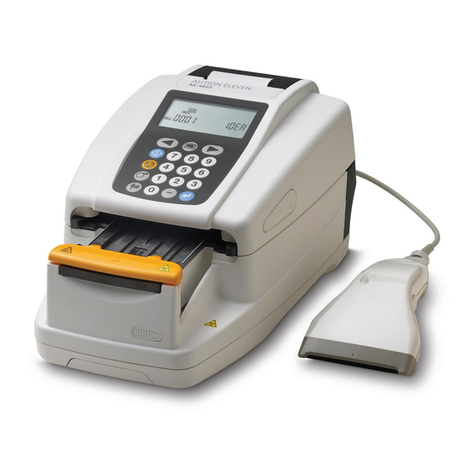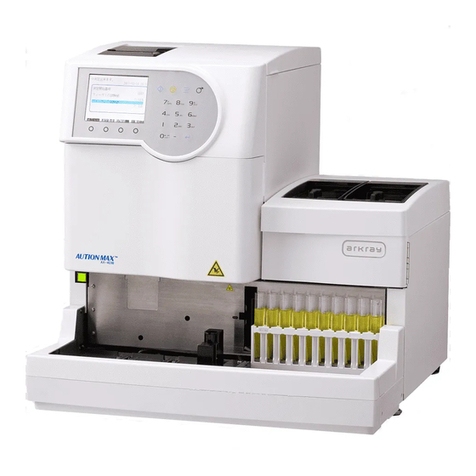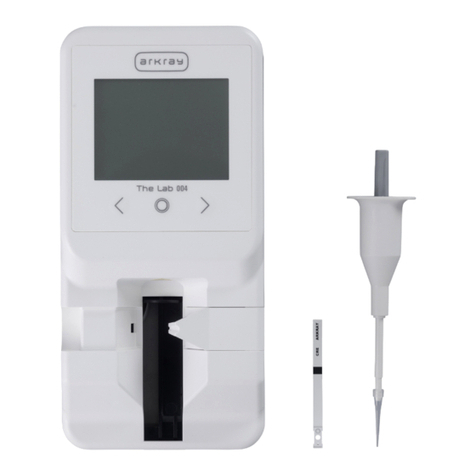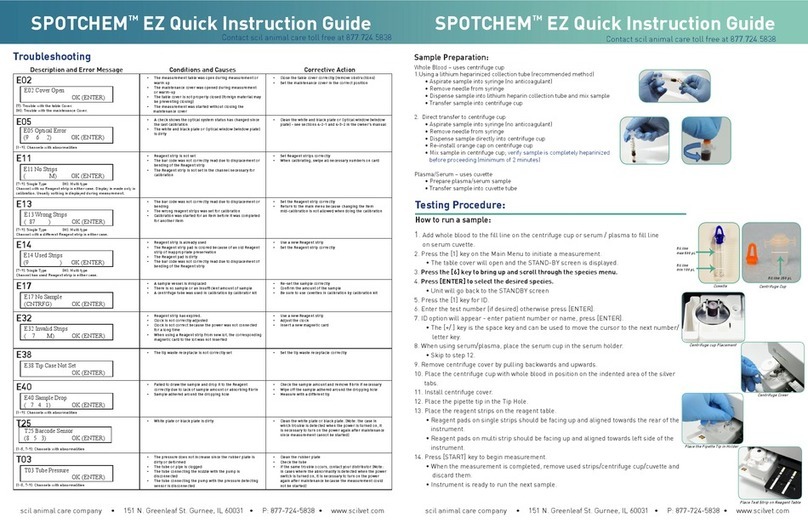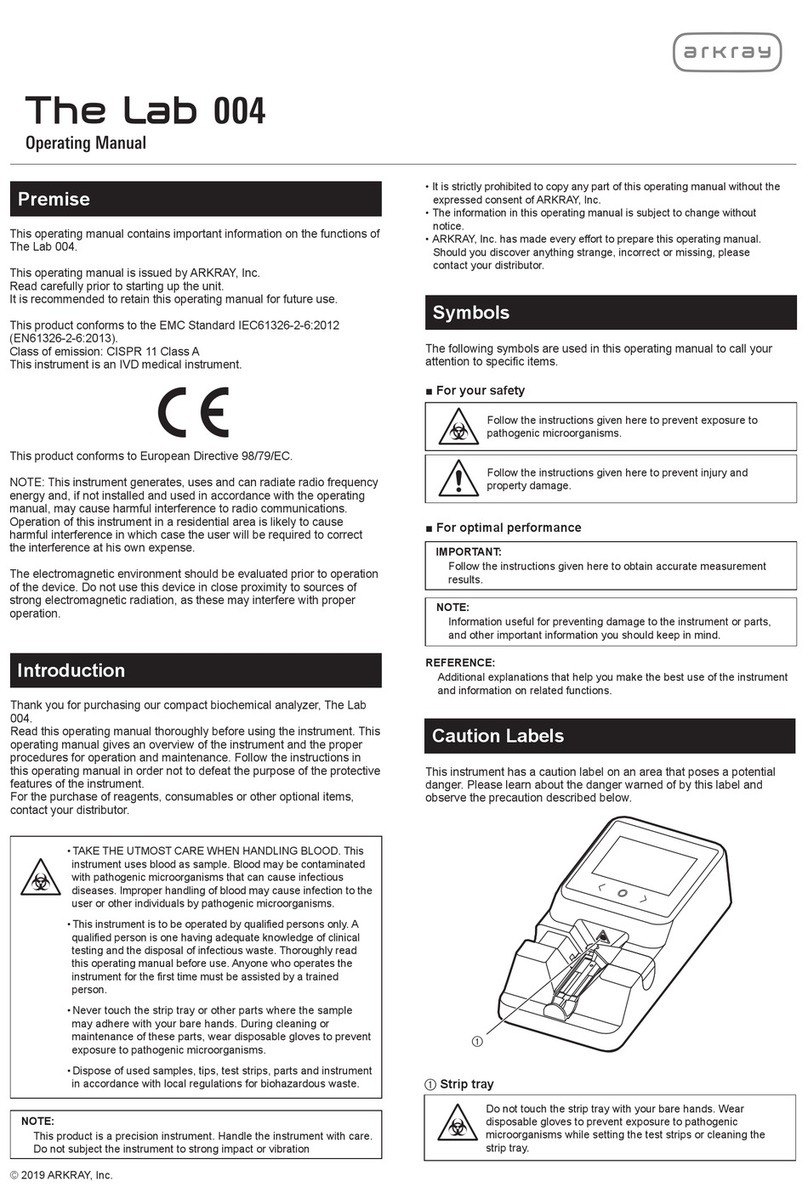
3
SEMI-AUTOMATED URINE ANALYZER
AUTION ELEVEN
™
AE-4022 Sample Measurement
1. Enter operator ID number (if function is ON).
• From the Standby Screen, press and hold
Measurement
Name of each part
Display
Operator panel
Test strip tray
Carrying arm Cover open button
(on both sides)
Waste box
Maintenance cover
Built-in printer
Rails (white)
Test strip detection
window
Preparation of measurement
Setup (test strip, measurement No., patient ID)
Measurement
Check that there is no used test strips in the waste box.
with buttonsSelect
[ Select test strip type ] [ Menu screen ]
Select the type of test strip
Dip the entire test strip pad area in the sample for two seconds.
IMPORTANT
Do NOT wet the black mark.
After dipping the test strip in the sample,
remove excess urine by letting the strip
touch the edge of the collection cup.
Set the measurement number
Place a test strip over the detection area of the test
strip detection window, crossing the two white rails
of the test strip tray.
The carrying arm sends the test strip into the
analyzer, and the measurement starts automatically.
Set the patient ID
When measuring continuously, repeat steps 1 to 3 .
Set measurement numbers and patient IDs as necessary.
When the buzzer setting is ON, the beeper sounds
for two seconds to signal the timing for dipping the
next test strip.
Dip the test strip while you hear the beep.
Turn off the instrument after completing all the measurement procedures.
Turn on the power switch at the back of the instrument.
Prepare a sufficient volume of sample in urine collection cup so
that the entire test strip pad area can be dipped in a single
motion. Stir well.
Waste box
Test strip
Test strip
pad area
Do NOT wet the
black mark.
Test strip
Rails (white)
Test strip detection window
Detection
area
(up to 13 digits)
,
(up to 4 digits)
for 3 seconds.
• Enter operator ID number using numeric and [-] keys or using barcode reader.
• Press
Measurement
Name of each part
Display
Operator panel
Test strip tray
Carrying arm Cover open button
(on both sides)
Waste box
Maintenance cover
Built-in printer
Rails (white)
Test strip detection
window
Preparation of measurement
Setup (test strip, measurement No., patient ID)
Measurement
Check that there is no used test strips in the waste box.
with buttonsSelect
[ Select test strip type ] [ Menu screen ]
Select the type of test strip
Dip the entire test strip pad area in the sample for two seconds.
IMPORTANT
Do NOT wet the black mark.
After dipping the test strip in the sample,
remove excess urine by letting the strip
touch the edge of the collection cup.
Set the measurement number
Place a test strip over the detection area of the test
strip detection window, crossing the two white rails
of the test strip tray.
The carrying arm sends the test strip into the
analyzer, and the measurement starts automatically.
Set the patient ID
When measuring continuously, repeat steps 1 to 3 .
Set measurement numbers and patient IDs as necessary.
When the buzzer setting is ON, the beeper sounds
for two seconds to signal the timing for dipping the
next test strip.
Dip the test strip while you hear the beep.
Turn off the instrument after completing all the measurement procedures.
Turn on the power switch at the back of the instrument.
Prepare a sufficient volume of sample in urine collection cup so
that the entire test strip pad area can be dipped in a single
motion. Stir well.
Waste box
Test strip
Test strip
pad area
Do NOT wet the
black mark.
Test strip
Rails (white)
Test strip detection window
Detection
area
(up to 13 digits)
,
(up to 4 digits)
to confi rm entry.
2. Confi rm display shows 10EA as test strip type.
3. Set measurement number (optional).
• If using 0001 for fi rst measurement number, go to step 4.
• Enter new number using keypad
Measurement
Name of each part
Display
Operator panel
Test strip tray
Carrying arm Cover open button
(on both sides)
Waste box
Maintenance cover
Built-in printer
Rails (white)
Test strip detection
window
Preparation of measurement
Setup (test strip, measurement No., patient ID)
Measurement
Check that there is no used test strips in the waste box.
with buttonsSelect
[ Select test strip type ] [ Menu screen ]
Select the type of test strip
Dip the entire test strip pad area in the sample for two seconds.
IMPORTANT
Do NOT wet the black mark.
After dipping the test strip in the sample,
remove excess urine by letting the strip
touch the edge of the collection cup.
Set the measurement number
Place a test strip over the detection area of the test
strip detection window, crossing the two white rails
of the test strip tray.
The carrying arm sends the test strip into the
analyzer, and the measurement starts automatically.
Set the patient ID
When measuring continuously, repeat steps 1 to 3 .
Set measurement numbers and patient IDs as necessary.
When the buzzer setting is ON, the beeper sounds
for two seconds to signal the timing for dipping the
next test strip.
Dip the test strip while you hear the beep.
Turn off the instrument after completing all the measurement procedures.
Turn on the power switch at the back of the instrument.
Prepare a sufficient volume of sample in urine collection cup so
that the entire test strip pad area can be dipped in a single
motion. Stir well.
Waste box
Test strip
Test strip
pad area
Do NOT wet the
black mark.
Test strip
Rails (white)
Test strip detection window
Detection
area
(up to 13 digits)
,
(up to 4 digits)
(up to 4 digits).
• Press
Measurement
Name of each part
Display
Operator panel
Test strip tray
Carrying arm Cover open button
(on both sides)
Waste box
Maintenance cover
Built-in printer
Rails (white)
Test strip detection
window
Preparation of measurement
Setup (test strip, measurement No., patient ID)
Measurement
Check that there is no used test strips in the waste box.
with buttonsSelect
[ Select test strip type ] [ Menu screen ]
Select the type of test strip
Dip the entire test strip pad area in the sample for two seconds.
IMPORTANT
Do NOT wet the black mark.
After dipping the test strip in the sample,
remove excess urine by letting the strip
touch the edge of the collection cup.
Set the measurement number
Place a test strip over the detection area of the test
strip detection window, crossing the two white rails
of the test strip tray.
The carrying arm sends the test strip into the
analyzer, and the measurement starts automatically.
Set the patient ID
When measuring continuously, repeat steps 1 to 3 .
Set measurement numbers and patient IDs as necessary.
When the buzzer setting is ON, the beeper sounds
for two seconds to signal the timing for dipping the
next test strip.
Dip the test strip while you hear the beep.
Turn off the instrument after completing all the measurement procedures.
Turn on the power switch at the back of the instrument.
Prepare a sufficient volume of sample in urine collection cup so
that the entire test strip pad area can be dipped in a single
motion. Stir well.
Waste box
Test strip
Test strip
pad area
Do NOT wet the
black mark.
Test strip
Rails (white)
Test strip detection window
Detection
area
(up to 13 digits)
,
(up to 4 digits)
to confi rm entry.
4. Set patient ID.
• Press
Measurement
Name of each part
Display
Operator panel
Test strip tray
Carrying arm Cover open button
(on both sides)
Waste box
Maintenance cover
Built-in printer
Rails (white)
Test strip detection
window
Preparation of measurement
Setup (test strip, measurement No., patient ID)
Measurement
Check that there is no used test strips in the waste box.
with buttonsSelect
[ Select test strip type ] [ Menu screen ]
Select the type of test strip
Dip the entire test strip pad area in the sample for two seconds.
IMPORTANT
Do NOT wet the black mark.
After dipping the test strip in the sample,
remove excess urine by letting the strip
touch the edge of the collection cup.
Set the measurement number
Place a test strip over the detection area of the test
strip detection window, crossing the two white rails
of the test strip tray.
The carrying arm sends the test strip into the
analyzer, and the measurement starts automatically.
Set the patient ID
When measuring continuously, repeat steps 1 to 3 .
Set measurement numbers and patient IDs as necessary.
When the buzzer setting is ON, the beeper sounds
for two seconds to signal the timing for dipping the
next test strip.
Dip the test strip while you hear the beep.
Turn off the instrument after completing all the measurement procedures.
Turn on the power switch at the back of the instrument.
Prepare a sufficient volume of sample in urine collection cup so
that the entire test strip pad area can be dipped in a single
motion. Stir well.
Waste box
Test strip
Test strip
pad area
Do NOT wet the
black mark.
Test strip
Rails (white)
Test strip detection window
Detection
area
(up to 13 digits)
,
(up to 4 digits)
• Enter up to 13 digits using numeric and [-] keys or scan barcoded sample
with barcode reader.
• Press
Measurement
Name of each part
Display
Operator panel
Test strip tray
Carrying arm Cover open button
(on both sides)
Waste box
Maintenance cover
Built-in printer
Rails (white)
Test strip detection
window
Preparation of measurement
Setup (test strip, measurement No., patient ID)
Measurement
Check that there is no used test strips in the waste box.
with buttonsSelect
[ Select test strip type ] [ Menu screen ]
Select the type of test strip
Dip the entire test strip pad area in the sample for two seconds.
IMPORTANT
Do NOT wet the black mark.
After dipping the test strip in the sample,
remove excess urine by letting the strip
touch the edge of the collection cup.
Set the measurement number
Place a test strip over the detection area of the test
strip detection window, crossing the two white rails
of the test strip tray.
The carrying arm sends the test strip into the
analyzer, and the measurement starts automatically.
Set the patient ID
When measuring continuously, repeat steps 1 to 3 .
Set measurement numbers and patient IDs as necessary.
When the buzzer setting is ON, the beeper sounds
for two seconds to signal the timing for dipping the
next test strip.
Dip the test strip while you hear the beep.
Turn off the instrument after completing all the measurement procedures.
Turn on the power switch at the back of the instrument.
Prepare a sufficient volume of sample in urine collection cup so
that the entire test strip pad area can be dipped in a single
motion. Stir well.
Waste box
Test strip
Test strip
pad area
Do NOT wet the
black mark.
Test strip
Rails (white)
Test strip detection window
Detection
area
(up to 13 digits)
,
(up to 4 digits)
to confi rm entry.
• The measurement number and patient ID number will display alternately
on screen.
Chapter 2 Measurement Operation
AE-4022 2-12
2.3.4 Entering your operator ID number
When the operator ID function is ON, you need to enter your operator ID number before performing a test.
1 Call up the screen
aWith the [Standby screen] displayed, press and hold for 3
seconds.
• The [Operator ID number input screen] appears.
2 Enter your operator ID number
aEnter your operator ID number correctly using the numeric and
keys.
bPress .
• If your entry is valid, the display returns to the [Standby screen].
You are then permitted to perform measurement.
REFERENCE:
You can also enter the operator ID number by reading its
barcode.
REFERENCE:
Elapse of Operator ID Effective Time
When the Operator ID effective time elapses, the keys will not respond and/or testing will not start when a strip is
placed until you enter your operator ID.
Chapter 2 Measurement Operation
AE-4022 2-14
2.3.6 Entering patient ID numbers
Each patient ID number can have up to 13 digits of numeric figures and “–” characters entered. The patient ID number
entered is uniquely allocated to the measurement made just after this entry is made. After a group of measurements is
completed, the patient ID numbers are automatically deleted.
To manually input a patient ID number
1 Call up the screen
aWith the [Standby screen] displayed, press .
• The [Patient ID number input screen] appears.
2 Enter a patient ID number
aEnter a patient ID number.
• You can enter up to 13 digits using the numeric and keys.
REFERENCE:
In addition to the patient ID number, a measurement number is also allocated to each sample. The
measurement number is automatically incremented by one for each successive measurement from the start of
measurement until the instrument is turned OFF.
When using a hand-held barcode reader (optional), you need not manually enter the patient ID number. Follow
the procedures in “To enter a patient ID number using a barcode” on page 2-15.
NOTE:
If the input value exceeds 13 digits, the first digit (the
leftmost digit) will be deleted.
REFERENCE:
If a patient ID number has already been set, the highest-order digit (leftmost digit) flashes. If you then input a
number or “–”, the next digit to the right flashes. The flashing digit accepts key input.
If you press during input, the currently input patient ID number is cancelled and the instrument returns to
the [Standby screen].
2.3 Preparation for measurement
AE-4022 2-15
bPress .
• The recorded patient ID number is stored and the display returns
to the [Standby screen].
• Once the patient ID number is set, the “measurement number +
test strip type” and “patient ID number” are displayed alternately
on the [Standby screen].
To enter a patient ID number using a barcode
1 Call up the screen
aWith the [Standby screen] displayed, press .
• The [Patient ID number input screen] appears.
2 Enter patient ID number by reading its barcode
aUse a hand-held barcode reader to scan the barcode on the label,
which will enter the ID number when the [Patient ID number
input screen] is displayed.
2.3 Preparation for measurement
AE-4022 2-15
bPress .
• The recorded patient ID number is stored and the display returns
to the [Standby screen].
• Once the patient ID number is set, the “measurement number +
test strip type” and “patient ID number” are displayed alternately
on the [Standby screen].
To enter a patient ID number using a barcode
1 Call up the screen
aWith the [Standby screen] displayed, press .
• The [Patient ID number input screen] appears.
2 Enter patient ID number by reading its barcode
aUse a hand-held barcode reader to scan the barcode on the label,
which will enter the ID number when the [Patient ID number
input screen] is displayed.
Continued on next page…
